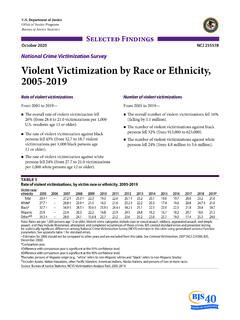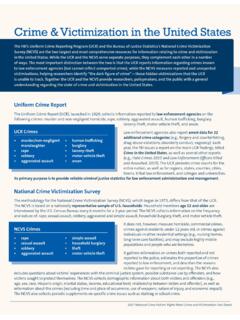Transcription of Mapping Crime: Understanding Hot Spots
1 Special Mapping crime : Understanding Hot Spots 05 Department of Justice Office of Justice Programs National Institute of Justice AUG. REPORT Department of Justice Office of Justice Programs 810 Seventh Street Washington, DC 20531 Alberto R. Gonzales Attorney General Regina B. Schofield Assistant Attorney General Sarah V. Hart Director, National Institute of Justice This and other publications and products of the National Institute of Justice can be found at: National Institute of Justice Office of Justice Programs Partnerships for Safer Communities AUG. 05 Mapping crime : Understanding Hot Spots John E. Eck, Spencer Chainey, James G. Cameron, Michael Leitner, and Ronald E.
2 Wilson NCJ 209393 Sarah V. Hart Director This document is not intended to create, does not create, and may not be relied upon to create any rights, substantive or procedural, enforceable by law by any party in any matter civil or criminal. Findings and conclusions of the research reported here are those of the authors and do not necessarily reflect the official position or policies of the Department of Justice. The products, manufacturers, and organizations discussed in this document are presented for informational purposes only and do not constitute product approval or endorsement by the Department of Justice. The National Institute of Justice is a component of the Office of Justice Programs, which also includes the Bureau of Justice Assistance, the Bureau of Justice Statistics, the Office of Juvenile Justice and Delinquency Prevention, and the Office for victims of crime .
3 Cover Credits (From left to right) Map by Jeff Stith and the Wilson, North Carolina, Police Department Map by Wilpen Gore, Heinz School of Public Policy and Management, Carnegie Mellon University, Pittsburgh, Pennsylvania Background map by Jeff Stith and the Wilson, North Carolina, Police Department About This Report Much of crime Mapping is devoted to detecting high- crime -density areas known as hot Spots . Hot spot analysis helps police identify high- crime areas, types of crime being committed, and the best way to respond. This report discusses hot spot analysis techniques and software and identifies when to use each one. The visual display of a crime pattern on a map should be consistent with the type of hot spot and possible police action.
4 For example, when hot Spots are at specific addresses, a dot map is more appropriate than an area map, which would be too imprecise. In this report, chapters progress in sophis tication. Chapter 1 is for novices to crime Mapping . Chapter 2 is more advanced, and chapter 3 is for highly experienced analysts. The report can be used as a com panion to another crime Mapping report published by the National Institute of Justice in 1999, crime Mapping : Principle and Practice, by Keith Harries. What did the researchers find? Identifying hot Spots requires multiple techniques; no single method is suffi cient to analyze all types of crime . Current Mapping technologies have sig nificantly improved the ability of crime analysts and researchers to understand crime patterns and victimization.
5 crime hot spot maps can most effective ly guide police action when production of the maps is guided by crime theories (place, victim, street, or neighborhood). Who should read this study? crime analysts and researchers in police departments. iii Contents About This Report .. iii Chapter 1. crime Hot Spots : What They Are, Chapter 2. Methods and Techniques for Why We Have Them, and How to Map Them .. 1 Understanding crime Hot Spots .. 15 Chapter 3. Spatial Analysis Tools for Identifying Hot Spots .. 35 Chapter 4. Conclusion .. 65 v Chapter 1. crime Hot Spots : What They Are, Why We Have Them, and How to Map Them John E. Eck, University of Cincinnati crime is not spread evenly across maps.
6 It clumps in some areas and is absent in others. People use this knowledge in their daily activities. They avoid some places and seek out others. Their choices of neighborhoods, schools, stores, streets, and recreation are governed partially by the Understanding that their chances of being a victim are greater in some of these places than in others. In some places people lock their cars and secure belongings. In other places they do not. Along some streets people walk swiftly and view approaching strangers with sus picion. Along other streets they casually stroll and welcome the next interesting person they might meet, and notice others making the same choices in the same areas.
7 Some might argue that this behavior merely shows that people are unreason ably fearful of some areas but not of oth ers. This may often be true, but the fact that people are not equally fearful of all places suggests that they understand that crime is not evenly distributed. People might be mistaken about the risks of some places, but they are not mistaken that their risk of being a victim of crime is not geographically constant. Police use this Understanding every day. Decisions about how to allocate scarce resources are based partially on where the demands for police are highest and where they are lowest. Officers are told to be particularly attentive to some behavior in some areas, but are given no guidance about other areas where this behavior is scarce.
8 Community policing is particularly attentive to high- crime neighborhoods, where residents have great difficulty exert ing social controls. Problem-oriented polic ing pushes police officials to identify concentrations of crime or criminal activity, determine what causes these concentra tions, and then implement responses to reduce these concentrations. Much of what is called crime analysis is dedicated to locating concentrations of crime hot Spots and much of crime Mapping is devoted to their detection. This chapter discusses how different inter pretations of hot Spots require different types of crime principal theme is that crime hot spot maps can most effectively guide police action when pro duction of these maps is guided by theory.
9 With the appropriate crime theory, crime maps can communicate vital information to police officials and community mem bers efficiently and effectively. Many useful crime theories provide guid ance for selecting Mapping symbols. Which theory is most useful depends on the type of problem being mapped. Maps that are not based on theory will provide officers with inadequate and even mislead ing information. The term hot spot has a number of mean ings. This chapter begins with a discussion of what the term means and how the meanings relate to the concept of levels of spatial analysis of crime . Different theories of crime explain crime at different levels, so this chapter briefly describes various 1 SPECIAL REPORT / AUG.
10 05 levels of crime theories and explains how they can be depicted on maps. This chap ter examines four types of crime theories in greater detail: place (point) theories; street (line) theories; area (polygon) theo ries; and repeat victim theories, which can operate on point, line, or polygon level. These theories describe the levels of hot Spots and how these levels can be depict ed on maps. This chapter examines why crime theory, crime Mapping , and police actions need to be consistent. The end of the chapter examines how the map sym bols implied by each theory communicate to users of crime maps. What is a hot spot? Areas of concentrated crime are often referred to as hot Spots .














